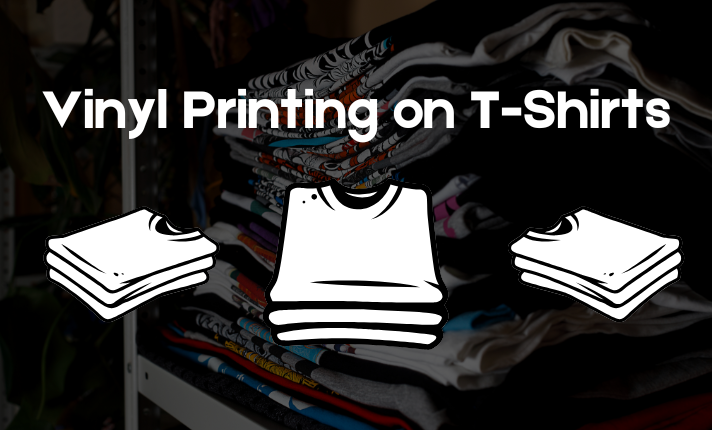Vinyl printing is a widely used method for creating custom designs on t-shirts. This process involves cutting out designs, letters, or logos from sheets of vinyl material using a specialized machine, such as a vinyl cutter or plotter. Once the design is cut, it is applied to the t-shirt using a heat press, which adheres the vinyl to the fabric under heat and pressure. The result is a vibrant, long-lasting design that stands out on the shirt’s surface.
Vinyl printing is an excellent choice for creating high-quality printed shirts with bold colors and precise details. It works best for smaller runs of t-shirts, as it offers a quick and efficient way to produce custom designs without the need for complex setup or screens, as required in screen printing.
One of the key advantages of vinyl printing is its versatility. This method allows for a wide range of design options, from single-color text to intricate multi-layered graphics. Additionally, vinyl is available in various finishes, including matte, glossy, metallic, and even glitter, making it ideal for achieving unique and eye-catching designs. For businesses or individuals looking for durable and visually appealing custom vinyl print shirts, vinyl printing is a go-to method. Read on to know more about vinyl printing on T-Shirts.
Is Vinyl Printing Better Than DTG Printing?
Deciding between vinyl printing and Direct-to-Garment (DTG) printing depends on the specific requirements of your project. While both methods have their strengths, they cater to different needs and design preferences.
Vinyl printing is often considered better for small quantities or designs that require bold, solid colors. This method allows for creating designs with clean edges and vibrant hues, making it perfect for text-based graphics or logos. Since vinyl is cut and applied manually, it also allows for layering, which adds depth and texture to the design. For businesses or individuals looking to create personalized, high-quality printed shirts, vinyl printing is an excellent choice for projects with limited runs.
On the other hand, DTG printing excels in handling complex and detailed designs, such as photographs or full-color artwork. DTG uses specialized inkjet technology to print directly onto the fabric, making it ideal for larger-scale productions or intricate designs with gradients and shading. However, DTG may not be as durable as vinyl, especially for garments that are frequently washed.
Ultimately, the choice between vinyl and DTG depends on your design complexity, order size, and intended use. If you need durable and bold designs for a small batch of shirts, vinyl print is the way to go.
How Long Does a Vinyl Print Last on Custom T-Shirts?
One of the standout features of vinyl printing is its durability. With proper care, a vinyl print can last for years, often outliving the t-shirt itself. This longevity makes vinyl an excellent choice for creating printed shirts that will maintain their appearance over time, even with regular wear and washing.
Vinyl prints are resistant to cracking, fading, and peeling, thanks to the high-quality materials used in the process. The heat press ensures that the vinyl adheres firmly to the fabric, creating a bond that withstands everyday use. For those who wear their custom t-shirts frequently, vinyl prints offer the assurance of a long-lasting design.
To maximize the lifespan of a vinyl print, it’s essential to follow proper care instructions. Washing the shirt inside out in cold water, avoiding harsh detergents, and air drying instead of using a dryer are all effective ways to preserve the vinyl’s integrity. Additionally, avoiding ironing directly over the vinyl design can prevent damage.
Whether you’re creating shirts for a team event, promotional merchandise, or personal use, vinyl printing ensures your designs stay vibrant and intact for years to come.
Which Printing is Best for a T-Shirt?
Choosing the best printing method for a t-shirt depends on factors like the design, budget, and intended purpose. Vinyl printing, DTG printing, and screen printing each have their unique advantages, making them suitable for different scenarios.
Vinyl printing is ideal for small batches and designs that prioritize durability and bold colors. It’s particularly well-suited for simple graphics, logos, or text-based designs. Vinyl prints are also versatile, offering various finishes like metallic or glitter, which can add a creative flair to your t-shirts.
DTG printing, on the other hand, is better for complex, multi-colored designs or detailed artwork. This method works well for large-scale projects or designs that require photo-realistic quality. However, DTG may not be as durable as vinyl, especially with frequent washing.
Screen printing is a traditional method that’s often preferred for bulk orders. It’s cost-effective for large runs and produces vibrant, high-quality prints. However, screen printing involves a more complex setup, making it less suitable for smaller quantities.
For those seeking versatility and longevity in their custom printed shirts, vinyl printing stands out as a reliable option. Each method has its strengths, so the best choice depends on your specific needs.
What is Better, Screen Printing or Vinyl Printing?
The debate between screen printing and vinyl printing often comes down to the project’s scope and design requirements. Both methods offer unique advantages, but they cater to different needs.
Screen printing is a tried-and-true technique that’s ideal for large-scale productions. It uses stencils and ink to transfer designs onto fabric, producing vibrant and durable prints. This method is cost-effective for bulk orders and works well for designs with fewer colors. However, screen printing requires a significant setup process, making it less practical for small batches or one-off designs.
Vinyl printing, by contrast, is better suited for smaller quantities and designs that require bold, solid colors. The process is simpler, as it doesn’t involve creating screens or stencils. Vinyl printing also allows for unique finishes, such as metallic or glitter, which can add a personalized touch to the shirts.
If you’re looking to create custom vinyl print shirts with durability and creative finishes, vinyl printing is the better option for smaller projects. For larger orders or designs with minimal colors, screen printing might be the more economical choice.
Does Vinyl Print Crack?
One of the most common concerns about vinyl printing is whether the design will crack over time. High-quality vinyl prints are designed to resist cracking, provided the t-shirt is cared for properly. The durability of a vinyl print depends on factors like the quality of the vinyl material, the heat press process, and how the garment is maintained.
Vinyl prints are made to withstand regular wear and washing. The heat press creates a strong bond between the vinyl and the fabric, ensuring the design remains intact. However, improper care—such as using harsh detergents, washing in hot water, or over-drying—can lead to cracking or peeling.
To prevent cracking, always wash the t-shirt inside out, use cold water, and avoid high heat when drying. Following these care tips can keep your printed shirts looking fresh and vibrant for years.
How to Remove Vinyl Print from a Shirt?
Removing a vinyl print from a shirt can be challenging, but it’s not impossible. Whether you want to update an old t-shirt or correct a mistake, there are a few methods you can try to remove the vinyl.
One common approach involves using heat. You can apply heat to the vinyl design with an iron or heat gun to loosen the adhesive. Once the vinyl softens, carefully peel it off using tweezers or a similar tool. Be cautious not to damage the fabric during this process.
Another method is to use a chemical adhesive remover. Products like rubbing alcohol, nail polish remover (acetone), or specialized vinyl removers can help break down the adhesive. Apply the solution to the back of the design and gently peel away the vinyl. Always test the solution on a small, inconspicuous area of the shirt first to ensure it doesn’t damage the fabric.
Removing a vinyl print may leave some adhesive residue behind. Washing the shirt or using a fabric-safe cleaner can help remove any remaining traces. Keep in mind that attempting to remove vinyl may not always restore the shirt to its original state, so proceed with care.
if you are looking for the best store to shop for custom shirts? PP Apparel Hub is the best place to have a custom made t-shirts.
FAQs
What is a Vinyl Print?
A vinyl print is a design created by cutting shapes, patterns, or text from vinyl sheets and transferring them onto fabric using heat.
What is Vinyl on Clothing?
Vinyl on clothing refers to the use of heat-transfer vinyl (HTV) to create custom designs on garments. The vinyl is adhered to the fabric with a heat press, ensuring the design stays in place even after multiple washes.
Does Vinyl Come Off Shirts?
Yes, vinyl can be removed from shirts using heat, adhesive removers, or other methods. However, the process requires care to avoid damaging the garment.
How to Use Iron-on Vinyl?
To use iron-on vinyl, cut your design using a vinyl cutter, place it on the fabric, and press it with a hot iron or heat press. Follow the manufacturer’s instructions for temperature and pressing time for the best results.
What Printing Method Do Luxury Brands Use?
Luxury brands often use screen printing, embroidery, or digital printing methods like DTG for their garments. These methods ensure high-quality, long-lasting results that align with their premium standards.



